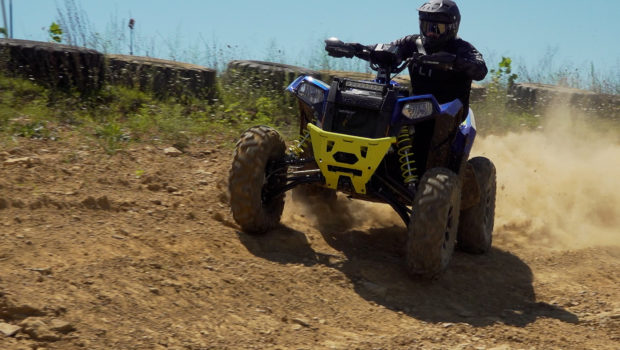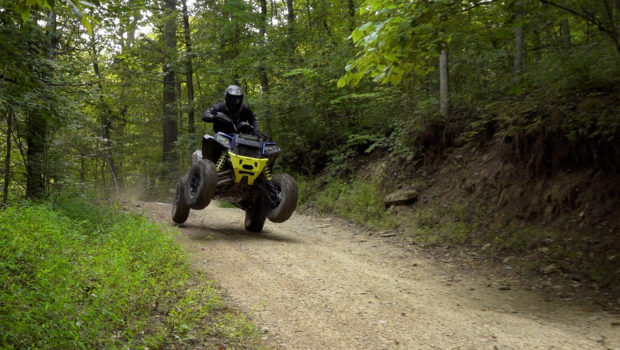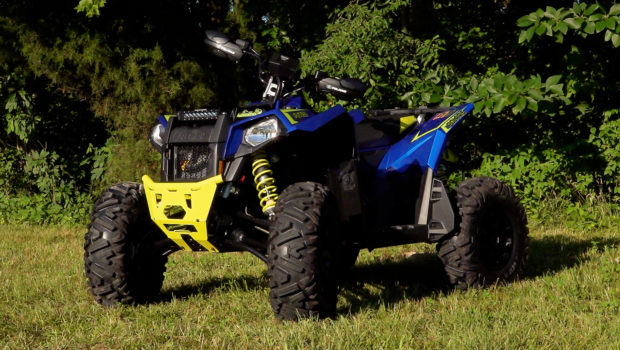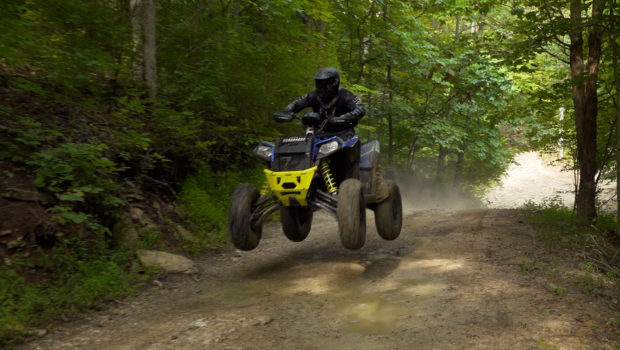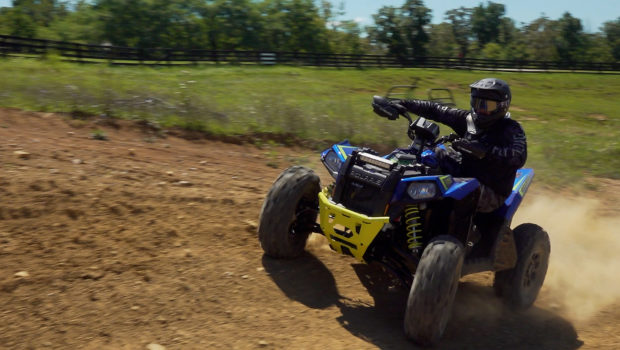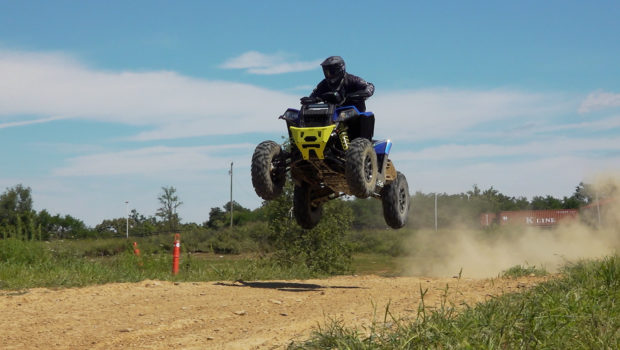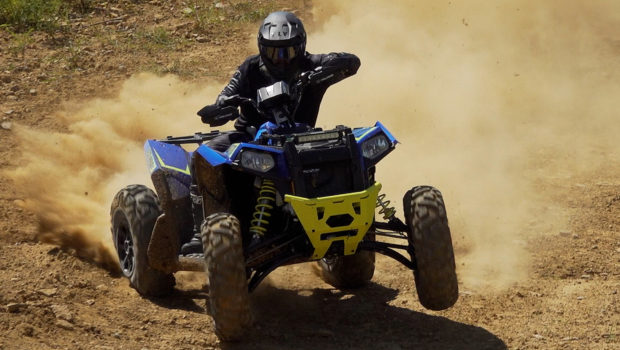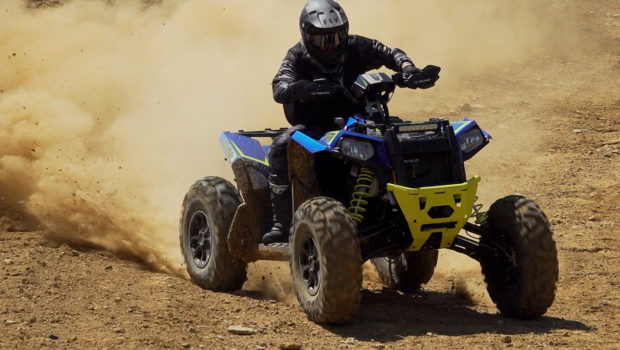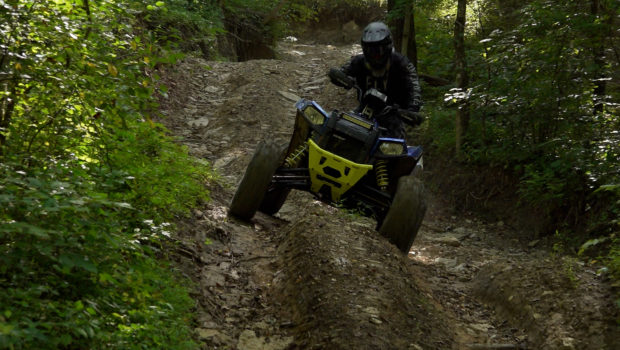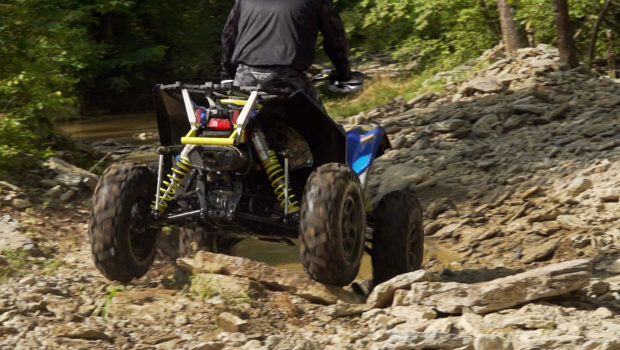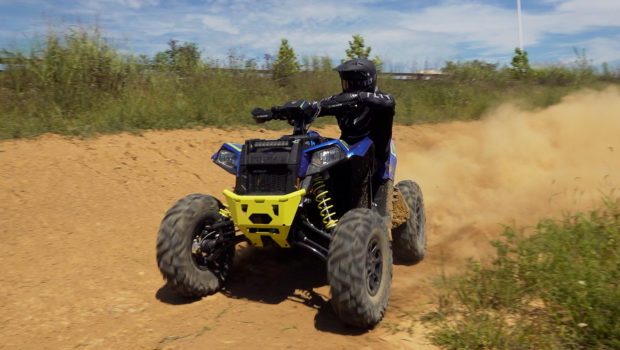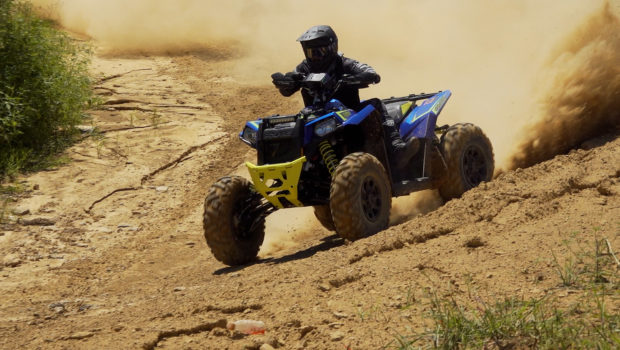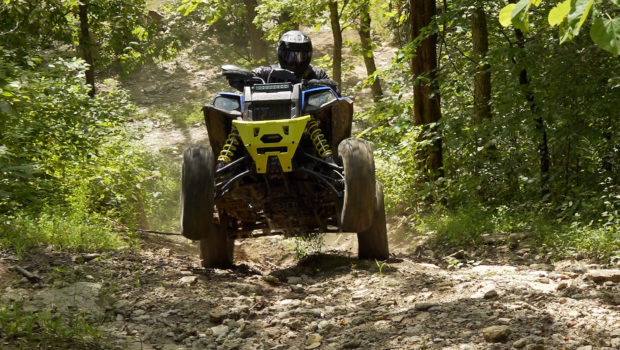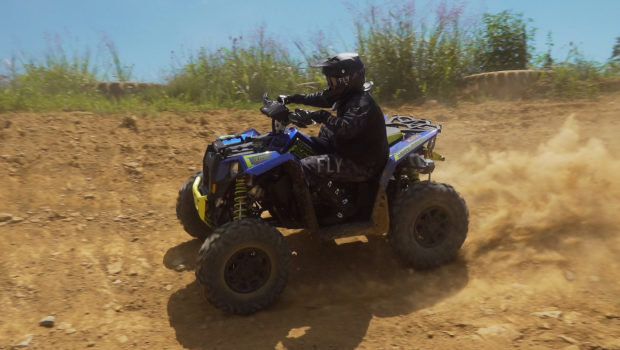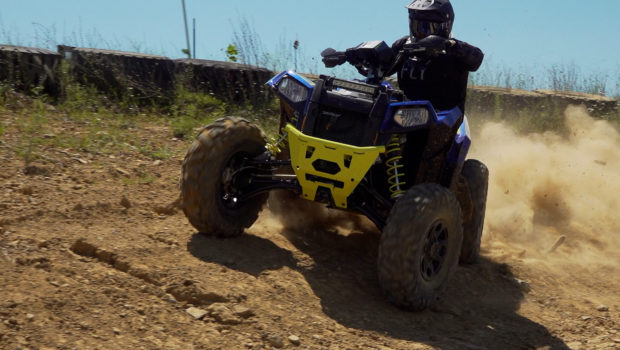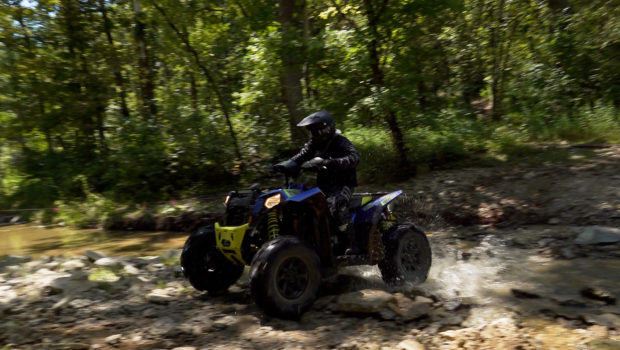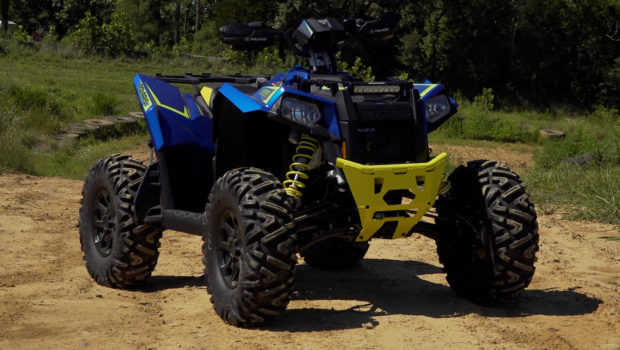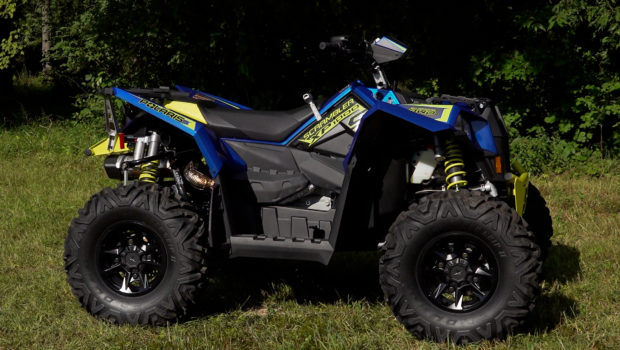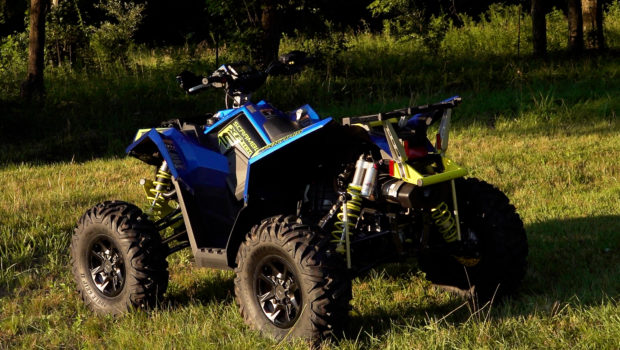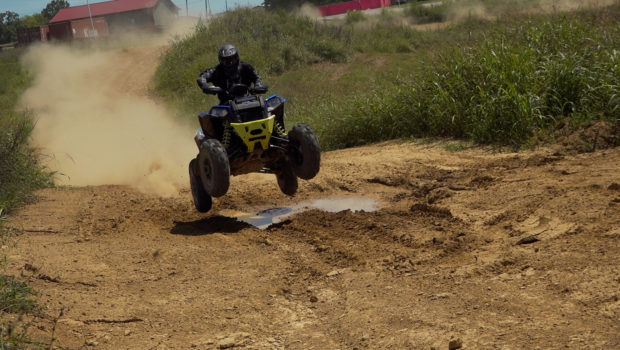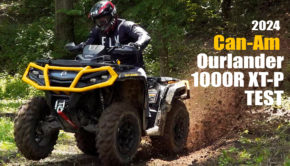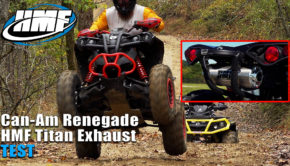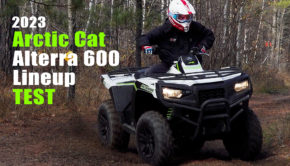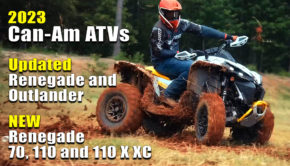Published on October 4th, 2022 | by Joe
2023 Polaris Scrambler XP 1000 S Test Review
Testing Polaris’ updated King of Extreme Terrain
Polaris shocked the ATV world in 2019 with the launch of the 55” wide, 2020 Scrambler S and Sportsman S models. After testing both machines at Polaris’ March, 2019 press event in the Nevada desert, we went on to produce our Scrambler S series with an East Coast test and head-to-head rides with some of the top big-bore 4×4 and sport ATVs on the market.
The Scrambler S is arguably the most radical ATV ever made. It’s one of the top horsepower producers with 89HP. Its 55” width and 57.4” wheelbase, 14.5” of ground clearance, and over a foot of highly-adjustable suspension travel at both ends allow the Scrambler S to hammer whoops and rip jumps like no other 4×4 could ever dream, while easily conquering rutted and rock strewn trail surfaces left over from a decade of side-by-sides.
While the Sportsman S returned to Polaris’ lineup with the release of the other 2022 ATV models last year, we were a little sad that the Scrambler S was missing from the lineup, especially considering Polaris had switched from Premium, reservoir-equipped Walker Evans shocks on the Sportsman S to basic five-way preload adjustable shocks for the 2022 model year. In January of 2022, Polaris announced that the Scrambler S would be rejoining their ATV lineup, including its high-end Walker Evans shocks along with Polaris’ brand new Multi-Select electric power steering, and a bold new look for 2022 that’s carried over to 2023.
With mixed feelings among our riders regarding the Scrambler’s power steering on the 2020 and 2021 models, we were thrilled to have the opportunity to throw a leg over the updated version of Polaris’ ultimate thrill ride.
Cross-country racer, Evan Hartzel, was part of our 2020 1000cc 4×4 ATV Shootout and 2021 Can-Am Renegade 1000R X XC Test giving him a good amount of experience on the most powerful 4×4 ATVs on the market. He was eager to experience the Scrambler S, dawning a brand-new, ultra-light, and highly-protective Fly Racing Formula Carbon Solid Helmet for our filming session at Dirty Turtle Off-Road Park in Bedford, Kentucky. There, we hit the jumps and bowl turns on the side-by-side track, then hit the trails to put the updated Scrambler S to the test.
Engine
Pumping out 89 horsepower, the Scrambler is powered by Polaris’ proven 952cc, parallel twin-cylinder, Pro Star engine with four valves and single-overhead-cams per cylinder. A centrally mounted silencer shaves weight and centralizes mass. An electronic throttle features two throttle modes, Standard and Performance. Both offer full power with standard mode performing similarly to a standard cable actuated throttle. Sport mode ramps the throttle up more quickly earlier on in the throttle’s lever movement for quicker feeling acceleration.
Compared to the standard width Sportsman 1000 models, the Scrambler S transmission’s internal drive chain and sprocket were widened for added strength. The continuously variable transmission features high and low ranges, plus neutral, reverse, and park selected by a shift lever on the right side of the machine. Engine braking was left out due to the Scrambler’s sport focused design.
To help ensure driveline durability, Polaris borrowed the front differential out of their RZR S 1000 for use in the Scrambler S. The axles are also beefed up to deal with the machine’s added weight and more aggressive riding intentions. Drive-modes include two and all-wheel-drive selected by a toggle lever on the throttle housing.
Polaris ATVs fire up with the turn of the key. Regardless of temperature, it started right up and was ready to go with very little warm up time. Power is substantial and more than beginners should try to tame. However, Polaris tunes their 1000’s clutches for smooth off idle engagement. Low-end power is strong, but less arm ripping than the V-Twin Rotax used in the Can-Am Renegade 1000. This makes the Scrambler S easier to hold onto for longer periods of time and helps make the most of available traction by not being as explosive at lower RPMs. Of course, if you grab a handful of throttle, the Scrambler S will take off like a rocket.
Strong, smooth, low-end power is followed by a seamless transition into the engine’s insanely powerful and fast accelerating midrange and upper RPMs. Evan appreciated the throttle’s performance mode on the track, delivering more abrupt in-your-face initial power delivery when you crack the throttle. Evan felt sport mode paired well with two-wheel-drive allowing him to carry the most speed around the track by steering with the back end in turns. Standard mode was better suited for times when less power is desired.
The Scrambler S horsepower can be easily upgraded to meet or exceed that of the 91hp Renegade 1000 and run cooler with a good aftermarket exhaust and fuel tuning solution like those from HMF. Their dual Performance series, Titan Quiet or Titan XL, can also take around 3.5 to 8 pounds of weight off the machine. Their Titan QS exhaust and Fuel Optimizer made a noticeable difference in performance on the Sportsman 1000 powered by the same Pro Star engine. HMF also offers their steel front and rear bumpers, designed to be strong and light. Their HD front bumper fits up to a 3,500-pound winch.
When holding a line at speed on the trail is complicated by a lack of traction due to mud or loose rocks, a switch to All-Wheel-Drive instantly allows you to better hold a line in addition to clawing its way up some pretty impressive inclines if you have the talent. Polaris’ All-Wheel Drive system seems to deliver power to all four wheels, even in high traction conditions. It’s noticeable through the bars when you switch between two and all-wheel-drive. Those critical of the rear tires’ braking traction long before the front tires started pulling on Polaris ATVs might feel differently after riding a Scrambler S.
In spite of relentless driveline abuse in our three years of testing with the Scrambler S landing from big jumps, hammering whoops, and going full throttle across rocks in two-wheel-drive, we’ve yet to break an axle or any other part for that matter. This wouldn’t be possible with any other production 4×4 ATV.
While we don’t typically calculate mileage, ripping sideways wide open in two-wheel-drive burns through gas pretty quickly in the 5.25 gallon tank. We’d recommend keeping a 5 gallon can at the truck.
Chassis and Suspension
Designed from the ground up for its 55” width, suspension travel, and larger tires, the 1000 S frame is a claimed 31% stronger through the mid-section than the old Scrambler and 48-inch wide Sportsman models. All bolted joints are double sheared and boxed in at the rear of the quad. Up front, there’s a substantial front bumper featuring winch integration. A steel grab bar is found out back and the underside is protected by plastic skid plates.
Suspension geometry was optimized to help reduce tire scrub throughout more of the suspension travel for improved suspension feel. Dual A-Arms at both ends, with high-clearance lower front A-Arms mate up to Walker Evans’ 2.0 shocks. They feature spring preload and crossover adjustability, along with high and low-speed compression and rebound damping adjustments. They control an incredible 12.5” of wheel travel front and 14” of travel out back. A sway bar is found out back for added stability.
Designed to aid steering, Pro Steer essentially adds a linkage to the steering system moving the inner tie rod ends outward to reduce bump steer. Some experts think it’s brilliant; others feel it’s a gimmick. We had no issues with it.
A few of our test riders felt that the original power steering settings made steering feel too light at high speeds. To cure this, Polaris added three-mode, Multi-Select power steering for 2022 with three modes of assistance to choose from.
The Scrambler rides on 27×9-12 Duro Power Grip II tires at all four corners. This improves handling and allows you to swap tires front to back in the event of a flat. Polaris went with 12” cast-aluminum wheels instead of 14s, allowing for a larger tire sidewall yielding a more compliant ride and greater puncture resistance. For an ATV of this price, we are surprised by the lack of beadlock wheels.
Compared to the original Scrambler and Sportsman XP platform, the S is a claimed 6.4” wider at 55”. Its wheelbase is around 4” longer at 57.4” with the additional length added to the front. It enjoys 3” additional ground clearance at 14.5”. Seat height is near dirt bike levels at 37”. The Scrambler’s added durability, dimensions, and suspension have added up to a shockingly substantial dry weight of 881 lbs.
Evan was undeterred by the nosebleed seat height as he felt its long and wide dimensions make the Scrambler S incredibly stable allowing him to immediately become comfortable riding the machine. Suspension performance is incredible right out of the box. The large 27” tires and relatively plush shock settings made the numerous water ruts littering the track surface disappear. With this much suspension travel on tap, Polaris didn’t have to skimp on small bump compliance to gain bottoming resistance. The shocks eat up rocky sections providing decent articulation despite its rear sway bar.
Medium-sized hits are handled in stride leaving both rider and machine virtually unaffected. G-outs, large holes, and numerous jump landings all left suspension travel in reserve. It provided an unbelievably plush and compliant ride at speed, never once emitting a bottoming sensation. The Scrambler S suspension is magic!
Suspension performance and side-by-side like dimensions make the Scrambler S an astoundingly stable machine. Evan was backing the Scrambler S into turns like a solid axle sport ATV. When it wasn’t flying off jumps, the Scrambler felt composed and glued to the ground on rough straights or pitching it sideways in turns.
We’ve not been fans of the Duro Power Grip tires used on Polaris Sportsman 1000 models in years past. However, we really like the performance of the Duro Power Grip II tires used on the Scrambler S. They provided good forward and braking traction. They also steer more predictably than other tires we’ve tried on the Scrambler. We think their performance is fitting of the Scrambler S, and for that, they wear rather quickly, but that’s the price you pay for high-performance rubber. The square tire setup lets you rotate them often to maximize lifespan.
Riding the Scrambler in two-wheel drive allows you to steer pretty precisely with the rear end. This is fun in wide open terrain and lets you pivot the back end around in tight spaces. The front end has a little tendency to push in loose conditions when you’re not steering with the back end. Evan preferred the more accurate steering of All-Wheel-Drive on Dirty Turtle’s loose, rocky, off-camber trail sections.
Multi-Select electronic power steering should add the versatility some of our Scrambler test riders were hoping for. Evan preferred leaving the power steering in the Max setting all of the time, while others on staff who have ridden the 2023 model preferred the mid-assist setting for operating in two-wheel-drive. It feels less twitchy and provides a little more feel for the trail while still eliminating unwanted bump feedback. Low assist was found to be unnecessary. We’d trade it in for a rock crawl mode with even more assistance for rock crawling or mudding in all-wheel-drive. Still, it’s a big step forward we think riders will be happy with.
Power steering options further improve the Scrambler S’ outstanding straight line stability. Its added front end length makes it a superb descender and aids it on climbs a bit, although splitting the added 4-inches of wheelbase, the front and rear could have further enhanced climbing prowess on steep, ledge-filled trails.
On the ground, the stability, incredible suspension, and motor make the Scrambler S feel remarkably agile for a machine weighing 900 pounds wet. However, once you start jumping, you realize that you can’t toss the Scrambler around or easily make mid-air corrections. Fortunately, it’s pretty easy to set the Scrambler up for flight on take-off. Its suspension and sprawling dimensions help make up for slightly less than perfect landings. Still, the massive size and weight of this machine should be lurking in the back of your mind. This ain’t your daddy’s 400-pound sport ATV. It’s certainly not for beginners.
Brakes
Without engine braking to allow the Scrambler to coast through bumps, braking is handled by a single handlebar lever all-wheel braking, with a separate rear brake pedal, which slows the scrambler. Brake lines are steel braided for power and feel.
Stopping power was quite good for the weight of the machine. Power and feel through the hand lever are good. We often like to utilize the rear brake pedal to control brake bias front to rear and scrub off speed more quickly. Like other Polaris, we wish the rear brake pedal was lower making it easier to utilize.
Ergonomics and Additional Features
The Scrambler 1000 S features 3” handlebar riser, allowing the handlebars to pivot forward or rearward. Hand guards come standard from the factory. The seat has a hump seat type design that’s raised in the rear. The floorboards’ raised, plastic foot pegs are on the small side, especially if mud or snow come into play.
The Scrambler’s narrow midsection and plush seat make it relatively easy to move around on and comfortable for all-day rides. Our biggest complaint with the ergonomics aside from the smallish foot pegs is the rear rack, which can hit you in the rear end when you’re hanging off the back of the machine. Fortunately, it appears easy to remove for aggressive riding.
There’s an LED display with Bluetooth phone connectivity. A 12-volt power outlet and battery charger port are mounted on the handlebar-mounted pod. It’s prewired for a winch as well as hand and thumb warmers for those looking to build an Arctic ready Scrambler. 65 watt high beam and 50 watt low beam headlights are found up front with LED tail and brake lights used out back. Additional lighting is provided with a 12” Pro Armor LED light bar. It’s decked for high-speed exploration day or night.
Work Capability
In spite of the Sportsman S being designed as a pure sport 4×4, Polaris did offer some on board storage. Small racks front and rear offer 25 and 50 pounds of carrying capacity with integration for Polaris’ accessories. A small storage box is located under the rear rack .
Sharing its engine and chassis with the more work focused Sportsman S, the Scrambler S provides plenty of power and low gearing for towing. Although there’s no hitch stock, HMF offers a bolt-on, two-inch hitch receiver providing a lot of added work capability for little money.
Conclusion
Choosing between the Scrambler S and Sportsman S has become easier if you ask us. The entry level shocks now used on the Sportsman S are not rebuildable, and therefore, disposable. They can’t be firmed up as easily or tuned as much and can’t be revalved and resprung if you find the ride too soft. If you don’t need your ATV for work, the Scrambler is the stand out machine. If work is mandatory, you’ll be buying a Sportsman S and adding expensive aftermarket shocks to a machine that already costs as much as the Scrambler S.
For 2022 and 2023, Polaris made the Scrambler S even better. While it’s not the ideal machine for those who typically ride 50-inch trails, or those who race on tight cross-country courses. The Scrambler S is for those who want the ability to go faster, jump further, pound whoops with the dirt bikes, or conquer tougher terrain left over by side-by-sides. There’s nothing else like the Scrambler S, and it is one heck of a fun ATV to ride.

